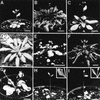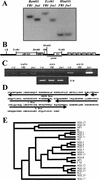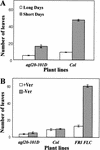The AGAMOUS-LIKE 20 MADS domain protein integrates floral inductive pathways in Arabidopsis
- PMID: 10995392
- PMCID: PMC316936
- DOI: 10.1101/gad.813600
The AGAMOUS-LIKE 20 MADS domain protein integrates floral inductive pathways in Arabidopsis
Abstract
The very late-flowering behavior of Arabidopsis winter-annual ecotypes is conferred mainly by two genes, FRIGIDA (FRI) and FLOWERING LOCUS C (FLC). A MADS-domain gene, AGAMOUS-LIKE 20 (AGL20), was identified as a dominant FRI suppressor in activation tagging mutagenesis. Overexpression of AGL20 suppresses not only the late flowering of plants that have functional FRI and FLC alleles but also the delayed phase transitions during the vegetative stages of plant development. Interestingly, AGL20 expression is positively regulated not only by the redundant vernalization and autonomous pathways of flowering but also by the photoperiod pathway. Our results indicate that AGL20 is an important integrator of three pathways controlling flowering in Arabidopsis.
Figures






Similar articles
-
Loss of FLOWERING LOCUS C activity eliminates the late-flowering phenotype of FRIGIDA and autonomous pathway mutations but not responsiveness to vernalization.Plant Cell. 2001 Apr;13(4):935-41. doi: 10.1105/tpc.13.4.935. Plant Cell. 2001. PMID: 11283346 Free PMC article.
-
FLOWERING LOCUS C encodes a novel MADS domain protein that acts as a repressor of flowering.Plant Cell. 1999 May;11(5):949-56. doi: 10.1105/tpc.11.5.949. Plant Cell. 1999. PMID: 10330478 Free PMC article.
-
A MADS domain gene involved in the transition to flowering in Arabidopsis.Plant J. 2000 Dec;24(5):591-9. doi: 10.1046/j.1365-313x.2000.00906.x. Plant J. 2000. PMID: 11123798
-
[Function of plant homeodomain-finger proteins in vernalization pathway in Arabidopsis and other cruciferous plants].Sheng Wu Gong Cheng Xue Bao. 2010 Jan;26(1):1-8. Sheng Wu Gong Cheng Xue Bao. 2010. PMID: 20353085 Review. Chinese.
-
Plant development going MADS.Plant Mol Biol. 2001 Jul;46(5):515-20. doi: 10.1023/a:1010689126632. Plant Mol Biol. 2001. PMID: 11516144 Review.
Cited by
-
Utilizing MIKC-type MADS-box protein SOC1 for yield potential enhancement in maize.Plant Cell Rep. 2021 Sep;40(9):1679-1693. doi: 10.1007/s00299-021-02722-4. Epub 2021 Jun 6. Plant Cell Rep. 2021. PMID: 34091722 Free PMC article.
-
Cloning and functional analysis of the flowering gene GmSOC1-like, a putative SUPPRESSOR OF OVEREXPRESSION CO1/AGAMOUS-LIKE 20 (SOC1/AGL20) ortholog in soybean.Plant Cell Rep. 2013 Aug;32(8):1219-29. doi: 10.1007/s00299-013-1419-0. Epub 2013 May 1. Plant Cell Rep. 2013. PMID: 23636663
-
The transcription factors and pathways underpinning male reproductive development in Arabidopsis.Front Plant Sci. 2024 Feb 8;15:1354418. doi: 10.3389/fpls.2024.1354418. eCollection 2024. Front Plant Sci. 2024. PMID: 38390292 Free PMC article. Review.
-
Characterization of EMU, the Arabidopsis homolog of the yeast THO complex member HPR1.RNA. 2010 Sep;16(9):1809-17. doi: 10.1261/rna.2265710. Epub 2010 Jul 28. RNA. 2010. PMID: 20668032 Free PMC article.
-
FIONA1-Mediated m6 A Modification Regulates the Floral Transition in Arabidopsis.Adv Sci (Weinh). 2022 Feb;9(6):e2103628. doi: 10.1002/advs.202103628. Epub 2022 Jan 5. Adv Sci (Weinh). 2022. PMID: 34989479 Free PMC article.
References
-
- Bechtold N, Ellis J, Pelletier G. In planta Agrobacterium-mediated gene transfer by infiltration of adult Arabidopsis thaliana plants. C R Acad Sci. 1993;316:1194–1199.
-
- Blázquez M, Soowal L, Lee I, Weigel D. LEAFY expression and flower initiation in Arabidopsis. Development. 1997;124:3835–3844. - PubMed
-
- Burn JB, Smyth DR, Peacock WJ, Dennis ES. Genes conferring late flowering in Arabidopsis thaliana. Genetica. 1993;90:147–155.
-
- Chandler J, Dean C. Factors influencing the vernalization response and flowering time of late flowering mutants of Arabidopsis thaliana (L.) Heynh. J Exp Bot. 1994;45:1279–1288.
Publication types
MeSH terms
Substances
LinkOut - more resources
Full Text Sources
Other Literature Sources
Molecular Biology Databases
